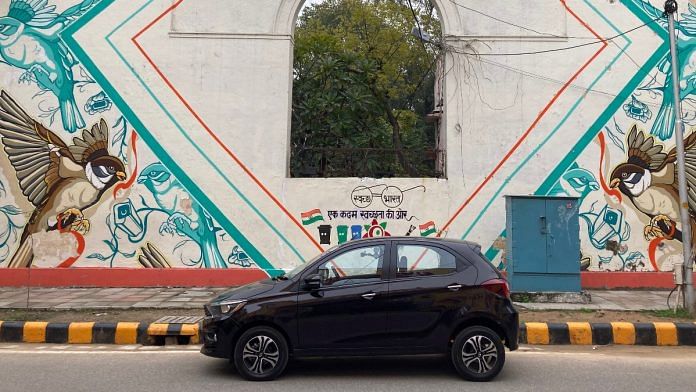On 7 March, around two weeks after Russian troops entered Ukraine, the Government of India finally bit the bullet and the Oil Marketing Companies raised prices of petrol and diesel. Companies retailing compressed natural gas were also allowed to raise the price. In the three months since then, Indraprastha Gas Limited, the monopoly distributor of CNG in the National Capital Region has raised prices of the cost-efficient fuel a cumulative 13 times, last on 21 May, with a kilogram now costing Rs 75.61, almost half as much more than it did back at the end of 2021. In fact, since March, the retail price of CNG has increased Rs 19.60/kg and unlike petrol or diesel, gas buyers haven’t been cut any excise slack. You can see this price increase reflected in your auto and taxi fares as well as in your gas bills in case you own a piped gas connection.
Price hikes notwithstanding, demand for CNG vehicles is still sky-high. So much so, that CNG has played a major role in helping Tata Motors’ post robust sales numbers. The passenger vehicle arm of one of India’s largest industrial conglomerates has been challenging Hyundai Motor India for the second spot on the sales charts over the past few months and two of the vehicles helping them are its small hatchback the Tiago and its compact sedan sibling, the Tigor. Combined, the two, over the past few months, have been selling between 8,500-9000 units monthly. In late January, Tata Motors launched the ‘iCNG’ variants of both cars and according to Rajan Amba, vice-president, sales marketing and customer care, Tata Motors, the new variants contribute to 52 per cent of the sales of the two models.
What’s driving sales
Clearly, it isn’t just taxi operators choosing CNG cars nowadays. Factory-fitted CNG vehicles now account for eight per cent of passenger vehicle volumes in India. And there are quite a few reasons for that. First and foremost being a marked improvement in the quality of CNG kits being offered by carmakers.
India’s top-three manufacturers, Maruti-Suzuki, Hyundai and Tata, making CNG vehicles available has given a boost to sales. Shashank Srivastava, executive director, sales and marketing, Maruti-Suzuki, said that the country’s largest carmaker sold 2.35 lakh CNG-fitted vehicles in the fiscal year ended March 2022.
The second reason for this surge is the dramatic expansion of the CNG network in India. According to Amba, currently, India has around 3,000 CNG pumps and that number is expected to touch 10,000 by 2030.
CNG vehicles can also switch to running on petrol with a push of a button (albeit not as efficiently as a pure-petrol vehicle). This assuages CNG owners that they will not ‘run out of gas’ at some godforsaken hour in the middle of nowhere. New factory-fitted kits also use space more efficiently, store more gas and despite the steep rise in gas prices, CNG vehicles on an average remain between Rs 2-3 per kilometer cheaper to operate than petrol ones. And residents of the NCR, used to the quixotic ‘odd-even’ rule during days of heavy pollution, know that CNG vehicles are exempt from it.
There is more to it. CNG vehicles have become a lot nicer to drive. In January, when Tata Motors showcased the new ‘iCNG’ range of the Tiago and Tigor, I drove a Tiago iCNG around Delhi. Not so long ago, not only were CNG options usually fitted on the entry-level variants but were also thoroughly unexciting to drive. The Tiago iCNG I got my hands on was a top-specification complete with a touchscreen infotainment system — a casual driver might not have noticed they were in a CNG car. It looks no different from a petrol/diesel variant small hatchback. And that is the best compliment one can give a modern CNG vehicle that have come a long way from the early days.
Also read: Ethanol blended fuel to power vehicles. Will it hurt your car’s engine?
Minimising the price differential
Tiago XZ+ DT, the top specification of the Tata hatchback has an ex-showroom price of Rs 7,79,900, just a Rs 35,000 premium over the petrol model. The savings of a couple of rupees per kilometer therefore ought to make up the price difference in less than a couple of years even for non-commercial customers. Tata Motors was the first manufacturer in India to offer CNG variants on their top trims and Amba says that customers are not purely buying a CNG vehicle from the lens of a low-running cost. He says that the top trims of the Tiago and Tigor iCNG account for half of the sales of the gas-powered variants for Tata. Unsurprisingly, Maruti-Suzuki, which recently gave their Ertiga and XL6 a mid-life facelift, now also offers CNG variants on their top-end ‘Alpha’ specification.
The minimal cost difference and the fact that gas-powered vehicles remain cheaper to run than petrol, as well as being relatively more environmentally friendly, sales can only keep rising. And if they feel little or no different when it comes to drivability vis a vis petrol, that is the icing on the cake. Little wonder then that Srivastava expects Maruti-Suzuki to sell over 600,000 CNG-fitted vehicles in the coming year. With 130,000 pending orders yet to be fulfilled, the carmaker is on track to hit those ambitious targets.
@kushanmitra is an automotive journalist based in New Delhi. Views are personal.
(Edited by Anurag Chaubey)



